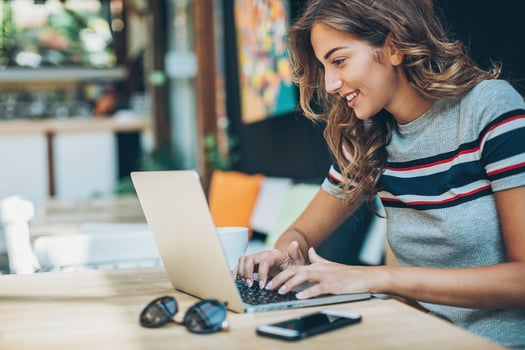During the last three years, it’s become clear to companies and recruitment marketing professionals alike that seasonal hiring is no longer a matter of simply “switching gears” from one recruiting strategy to another throughout the course of a year. Not only have cultural and social concerns (e.g., more emphasis being placed on DEIB initiatives and corporate responsibility) come into play more prominently, but the increased influence of technology has revolutionized how job seekers search for jobs and how organizations attract quality talent.
Of course, the pandemic further complicated matters, driving a demand for remote work opportunities and emphasizing work-life balance, which had already become a force to be reckoned with in the recruiting ecosystem.
This summer’s hiring season promises to be no less challenging for companies, recruiters, and candidates seeking jobs and internships, accentuating the current job market volatility. While there are plenty of opportunities for job seekers, a readiness to adjust the sails on the part of recruitment marketing professionals may prove to be the most advantageous mode of operation.
Part 1: The State of Summer Hiring
Though the dynamics above remain largely in play, this year, economic aspects are even more of a factor in the recruiting dynamic than usual. High inflation and rising interest rates have impacted businesses, consumers, and job seekers.
A Snagajob survey from early May in which 100 employers and 850 job seekers responded revealed that 60% of employers have already begun hiring for the summer season, and that 62% plan to hire more seasonal workers than they hired in 2022. According to the sample, 84% of candidates have already started looking for summer work. This translates into 1.8 available jobs for every candidate actively looking for work.
All of this indicates that there are plenty of jobs to go around and that candidates are already hitting the pavement in search of work.

What Do Summer Job Seekers Want?
For recruitment marketers, this means additional homework. In other words, as well as understanding the current recruiting dynamic, they must focus on cultivating the greatest understanding of candidates’ motivations as possible, individually and globally. It also means having a sense of what job seekers prioritize in order of importance.
This means considering the question: What do summer job seekers want?
Based on the Snagajob survey mentioned above, the top two concerns among workers looking for summer jobs this year are earning money and gaining job experience. At the very least, they’re looking for an attractive wage so that they can meet their financial needs. Considering the effects of inflation mentioned earlier, this means that employers need to offer more competitive wages in order to attract quality talent.
As managers and recruiters are aware, the workforce is becoming younger. Thus, a key motivator among this group is gaining workplace experience because these job seekers know they need more experience. They’re aware that the experience they acquire this summer can be leveraged into better jobs during the next hiring season. So, they’ll be more likely to seek jobs that will provide them with skills they don’t currently have.
This year, 67% of summer job seekers occupy the Gen Z demographic, meaning they’re 24 years old or younger. As discussed previously in this space, recruiters need to become experts in the recruitment methods that most effectively attract younger job seekers.
Workplace Culture
Workplace culture plays a significant role in how job seekers determine the companies they wish to work for, whether they’re Gen Z seasonal workers or 45 year-old executives. Recruiters should also be mindful that job seekers have become more discriminating in this area.
According to Gallup, a strong workplace culture increases key performance metrics, resulting in an average 85% net profit increase over a 5-year period. Unfortunately, as of 2018, only 23% of U.S. employees strongly agreed that they could apply their organization's values to their work every day, and only 27% strongly agreed that they believed in their organization's values. So, there’s still some room for improvement.
Today, companies with a strong workplace culture appeal to job candidates, as this provides opportunities for growth and other things that younger workers value. Even Indeed has implemented a new Work Wellbeing score that is being placed front and center on employer profiles. It measures happiness, stress, purpose, and satisfaction – as well as 11 other key indicators.

Based on Snagajob's sampling, an appealing workplace culture means that workers are more likely to meet new people (over 40% of young job seekers surveyed consider this a high priority) and have an enjoyable time in the workplace.
Other high-priority concerns for younger seasonal workers include:
- Equity and parity: 69% want an employer who treats workers fairly.
- Opportunities for growth: 54% want employers who offer on-the-job training.
- Work-life balance: 55% seek employers who respect personal obligations like school, childcare, and elder care.
Refining the Recruitment Strategy
Based on the Snagajob 2023 State of Summer Hiring survey, key areas upon which companies and recruitment marketing professionals should focus this summer to round out a robust recruiting strategy include:
Wages
Up 4.4% over the last year, wages are continuing to rise. As a result, 47% of companies are increasing wages. To keep competitive, considering a bump in wages is a prudent measure.
In addition to vendors and laws pushing toward transparency, it’s clear that it’s what candidates want too. According to a recent study by ResumeLab, “77% of surveyed employees agreed that a lack of information about salary in job postings should be illegal.” Additionally, the lack of salary information in job postings drastically impacts candidates' likelihood of applying. When honing in on Gen Z, which is an ever-growing part of the total workforce today, 85% of upcoming and recent grads say they’re less likely to apply for a job if the company does not disclose the salary range in the job posting.
Optimized Postings
The three key components that surveyed summer job seekers said they need to see in job postings are:
- Hours & shifts
- Pay rate
- Location
Therefore, these should be front and center in any job posting. In fact, adding the rate of pay alone can increase application rates by 200%. In 2023, 84% of workers reported that they plan to use an online job site to search for work, primarily on their phones, so mobile compatibility is imperative!
Also, even though implementing QR codes or paper applications in person is beneficial for people interested in applying in store, it’s essential companies do not just rely on walk-ins to fill out applications – especially for seasonal hiring initiatives. It’s great to have those in person options to supplement recruiting efforts. Still, companies need to prioritize the mobile application and experience, since most job seekers are conducting their job searches online.

Part-Time Workers
Younger workers lead busy lives, especially socially. This translates into a majority seeking part-time employment. Over 65% of summer job seekers are looking for schedules with under 30 hours a week, and 58% of employers are accommodating by offering part-time work.
Hire With an Eye Toward Retention
Although seasonal jobs are temporary by nature, this doesn’t mean that when summer workers leave, they leave for good. Based on the Snagajob sample, 44% of summer job seekers said returning next season is highly probable, with 29% saying they would seriously consider doing so. As far as employers go, 70% of employers said that they plan to retain seasonal employees when possible. During the interview process, asking workers if they’re interested in staying or returning can open the door to having that discussion, and can save the time and cost of having to train new employees later on.
Part 2: Internship Opportunities are Cooling
An internship can be an exciting opportunity for students to learn more about the working world and their chosen areas of study. Despite the upheaval created in the US labor market by the coronavirus pandemic over the last few years, the job market remains resilient. That said, the postings for internships are down compared to last year, but are still up compared to 2019, according to research conducted by Indeed.
As of May 19 of this year, job postings for summer jobs were down 10.2% and for internships 14.7% compared to the same time last year. This doesn’t bode well for job seekers who got a late start in looking for an internship this summer. According to Indeed, those looking for internships may find far fewer opportunities compared to a year ago.

According to CNBC, at the present time, the top 10 most searched-for internships (as of March 2023) include:
- Accounting
- Graphic design
- Mechanical engineer
- Psychologist
- Engineer
- Data analyst
- Electrical engineer
- Social work
- Civil engineer
- Nursing
It is believed that economic instability in recent years may be driving people to consider jobs in these less volatile sectors.
Postings for internships have declined more conspicuously than postings for seasonal summer jobs, and the peak in internship postings was earlier this year (February 25 – two weeks earlier than in 2022 and 2019). “As of May 19, the number of internship postings still exceeded the level from the same day in 2019 by almost 18%. However, some of the advantages enjoyed by students in recent years may be fading for this year’s crop of internship candidates.” (Indeed).
Moving Forward
In the final analysis, while the seasonal hiring game has become more challenging than usual, the methods for engaging seasonal workers and interns are still fairly straightforward. Moving forward, the most relevant strategic elements that companies can apply are:
- Applying retention strategies to seasonal workers,
- Honoring the fact that workplace culture has become a competitive advantage,
- Reviewing advertising to ensure that messaging is appropriate for the demographic and platform,
- Having sufficient visibility into recruitment data to glean insights and pivot strategies, and
- Being ready to adjust the sails for each hiring season.
Today, decision makers in hiring recognize that candidates need more information in order to make a decision regarding where they want to work. Enabling the most effective communication about the organization's employment offerings through a broad set of channels is sure to pay dividends during the summer hiring season for companies that adopt these strategies.
—
If your organization is ready to up its summer hiring game, reach out to us! Partner with Recruitics as we revolutionize the way to find, attract, and convert top talent and help you become more precise, intuitive, and efficient.



